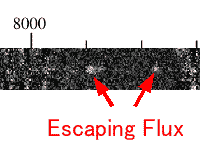A black hole two billion times more massive than the Sun is not something you find every day. Even more unusual is to find it embedded in a quasar that is 12.7 billion light years from Earth. But that’s just what Tomotsugu Goto (Japan Aerospace Exploration Agency) seems to have found using the Subaru optical-infrared telescope on Mauna Kea. How a black hole of this mass could have formed only a billion years after the birth of the universe is only one of the questions this find poses.
For the object, found in the direction of Cancer, also shows via its spectrum that much of the hydrogen between the quasar and Earth is ionized. What would cause neutral hydrogen to be converted to ionized hydrogen in this early epoch? Ultraviolet radiation is thought to be the key, but observational evidence helping us understand how and when this occurred has always been tricky to gather for a reionization event that occurred over 12 billion years ago.

Quasars are useful beacons by which to study this reionization. Gamma ray bursts are also helpful in determining how the phenomenon occurred, but they’re brief and sporadic, whereas quasars appear bright and stable over long periods of time. Hence Goto’s plan to investigate still more distant quasars using the same methods he used here: searching the Sloan Digital Sky Survey for objects having the same color in visible light as quasars at 12.7 billion light years distance, then observing the candidate objects on Mauna Kea to eliminate all but the quasars being investigated.
Image: The CCD image of the spectrum. The fact that light is detected between 800 and 830 nanometers indicates that much of the hydrogen between Earth and the quasar must be ionized. Credit: Subaru Telescope, National Astronomical Observatory of Japan (NAOJ).
Centauri Dreams‘ note: When the early universe cooled sufficiently, electrons and protons combined to produce neutral hydrogen, an event that probably began about 300,000 years after the Big Bang. Today most of that hydrogen has been ionized, splitting into separate electrons and protons; the absorption of light at particular wavelengths causes this to happen. Because the spectrum of this quasar shows there was not enough neutral hydrogen to absorb the light between the wavelengths of 800 to 830 nanometers, we can put further constraints on the state of ionization in the early universe.
A good backgrounder on all this, with links to other important quasar work, is available from Rennan Barkana (Tel Aviv University). Barkana is also the author of “The First Stars in the Universe and Cosmic Reionization,” Science 313. No. 5789 (18 August 2006), pp. 931-934, with abstract available here.


Hi Paul
One thing to remember with distant extra-galactic objects is that they have different “distance scales” depending on what you’re interested in. The quoted ‘distance’ is actually the light travel time, but the actual physical distance is quite a bit larger, and the luminosity distance is even larger. Professor Ned Wright at UCLA has an online cosmology tutorial (http://www.astro.ucla.edu/~wright/cosmo_02.htm#MD) which discusses these issues and also a handy Java distance calculator (http://www.astro.ucla.edu/~wright/CosmoCalc.html).
Plugging in a redshift of 6 gives an age of 12.7 gigayears, but the radial distance is actually 27.8 gigalightyears, due to the expansion while light travelled for 12.7 gigayears. The luminosity distance is even more extreme at 192.3 gigalightyears, which is why these events are so very hard to see and have to be fantastically luminous to be seen at all. As to why the luminosity distance is so large is due to the red-shift reducing the light intensity.
Of course the Hubble distance is model dependent, but the evidence for the ‘consensus’ Lambda-Cold Dark Matter (LCDM) cosmology is stronger than any current alternative. If incredibly luminous events with fixed light outputs occurred then they’d be immensely useful to cosmology – it’s hoped that type 1a Supernova are such a standard ‘candle’, and most of our cosmology assumes so.
Adam
Microquasars: summary and outlook
Authors: I. F. Mirabel
(Submitted on 15 May 2008)
Abstract: Microquasars are compact objects (stellar-mass black holes and neutron stars) that mimic, on a smaller scale, many of the phenomena seen in quasars. Their discovery provided new insights into the physics of relativistic jets observed elsewhere in the universe, and in particular, the accretion-jet coupling in black holes.
Microquasars are opening new horizons for the understanding of ultraluminous X-ray sources observed in external galaxies, gamma-ray bursts of long duration, and the origin of stellar black holes and neutron stars. Microquasars are one of the best laboratories to probe General Relativity in the limit of the strongest gravitational fields, and as such, have become an area of topical interest for both high energy physics and astrophysics. At present, back hole astrophysics exhibits historical and epistemological similarities with the origins of stellar astrophysics in the last century.
Comments: Review based on courses given at international schools for graduate students and post-docs; 13 pages, 7 color figures
Subjects: Astrophysics (astro-ph)
Cite as: arXiv:0805.2378v1 [astro-ph]
Submission history
From: Felix Mirabel [view email]
[v1] Thu, 15 May 2008 18:57:36 GMT (322kb)
http://arxiv.org/abs/0805.2378